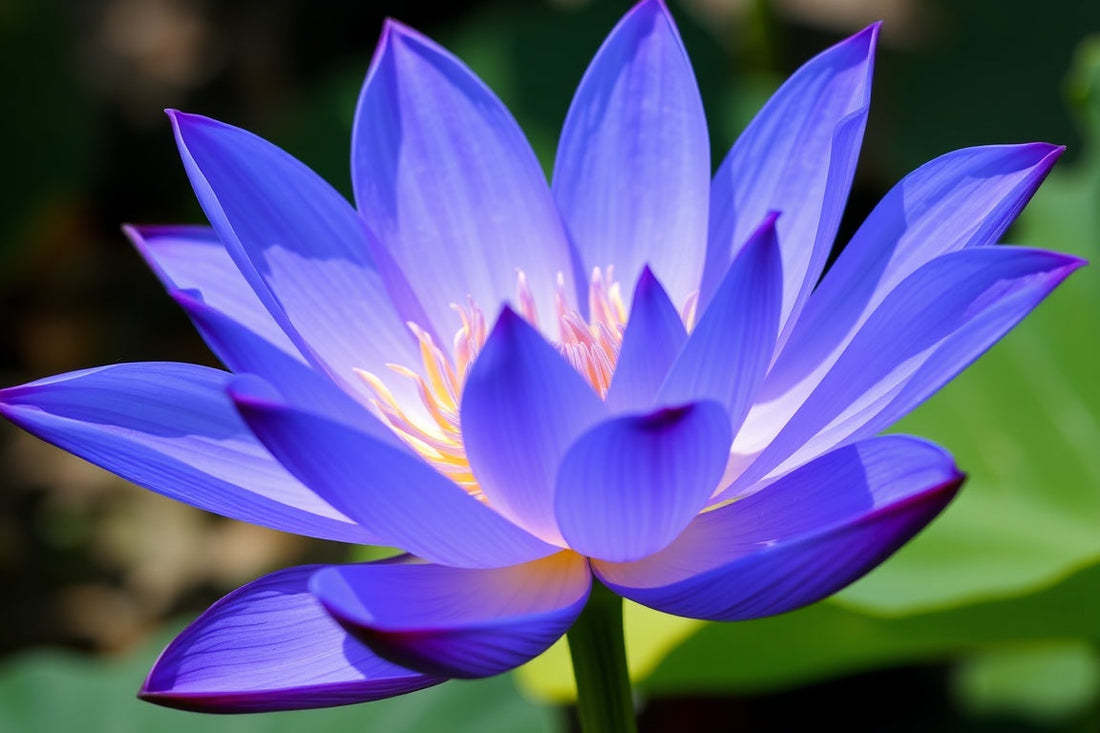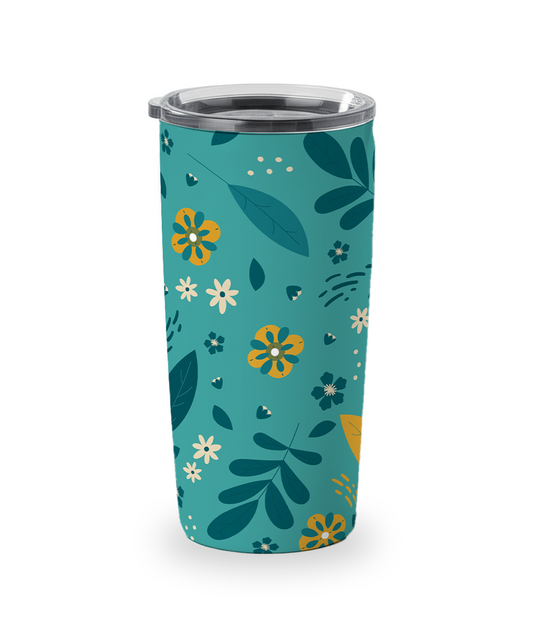
What Is Blue Lotus: Nymphaea Caerulea Benefits & Uses
Have you heard of the blue lotus?
It's a beautiful flower with a rich history.
People have used it for centuries.
Today, many enjoy it for its gentle effects.
Let's explore what makes the blue lotus so special.
Definition & Overview
What is Blue Lotus?
The blue lotus, also known as blue lily, is a captivating flower with a long history.
This aquatic plant is part of the water lilies family and is cherished for several reasons, including:
- Its inherent beauty.
- Its potential wellness benefits.
The blue lotus flower may promote relaxation and can be enjoyed as a tea or in aromatherapy.
Scientific Name: Nymphaea Caerulea
The scientific name for blue lotus is Nymphaea caerulea.
You might also see it listed as Nymphaea caerulea Savigny.
Knowing the scientific name helps to identify the flower accurately.
This ensures you are getting the true blue lotus.
Sometimes it is confused with other lotus flowers or nymphaea nouchali var.
Where It Grows
Historically, the blue lotus thrived along the Nile River in ancient Egypt.
Today, it can be found in various parts of the world.
These include Asia and East Africa. It prefers warm climates.
The blue lotus needs calm, shallow waters to flourish.
Its natural habitat provides the perfect conditions for this aquatic plant to grow. It needs a lot of sunlight.
Appearance of the Blue Lotus
Color and Shape of the Flower
The blue lotus flower is known for its striking color.
The blue flowers have a soft, serene hue.
The petals typically open in the morning.
They close again in the afternoon.
The shape is star-like and symmetrical. It looks like a beautiful offering to the sky.
The way the petals open is like a smile to the sun.
Distinctive Leaves
The leaves of the blue lotus are as distinctive as its flowers.
They are broad and round.
The leaves have a waxy coating.
This helps them float on the water's surface.
The leaves can span quite a distance.
They provide a lovely contrast to the delicate blue flowers. The blue lotus is a very pretty aquatic plant, indeed.
How It Looks in Nature
In nature, the blue lotus creates a stunning visual display. Imagine the vibrant blue flowers floating gracefully on the water. The broad green leaves provide a calming backdrop.
Dragonflies and other insects might visit. This helps the flower to grow and thrive. The blue lotus transforms any pond or water garden into a peaceful oasis. It looks amazing in nature.
History & Cultural Significance
Ancient Egypt and Its Importance
Ancient Egypt held the blue lotus in high esteem.
They considered it a sacred blue lily.
The Egyptian lotus was a symbol of rebirth and the sun.
The ancient Egyptian people often depicted the blue lotus flower in their art. You can find it on papyrus scrolls and in tomb paintings.
They seemed to revere the flower and it had a special place.
Symbolism of the Blue Lotus
The blue lotus flower carried deep symbolic meaning. The flower represented creation and rebirth. Its opening with the sun symbolized these ideas.
The ancient Egyptian people also associated it with the afterlife. They believed that the blue lotus may help with passage into the next realm. In art, the flower is a sign of transformation.
Historical Uses in Rituals
The use of blue lotus was common in rituals and ceremonies.
The ancient Egyptians used blue lotus as a part of their religious practices. Priests would often consume the flower to induce altered states of consciousness.
These experiences were thought to bring them closer to the gods. The sacred blue lily was used in many ways.
Traditional Uses of Blue Lotus
Relaxation and Sleep
Traditionally, people have used blue lotus for its relaxation and sleep-enhancing properties. The blue lotus may soothe the nerves. It is believed to calm the mind.
Drinking blue lotus tea before bed was thought to promote restful sleep.
It helped people unwind after a long day.
People use the flower for consumption in many different ways.
Rituals and Ceremonies
Beyond ancient Egypt, other cultures have incorporated the blue lotus into their rituals. It was used in ancient ceremonies to promote spiritual experiences.
Some believe that the psychoactive properties of the flower could enhance meditation. Shamans and healers used blue lotus to connect with the spiritual world.
It had a special place among healers.
Possible Aphrodisiac Properties
The blue lotus has a reputation as a possible aphrodisiac.
Some cultures believed that the flower could enhance sexual desire.
The ancient Egyptian people were known to use blue lotus as a love potion.
While scientific evidence is limited, the association persists. The blue lotus flower may help some people.
Modern Uses of Blue Lotus
Making Blue Lotus Tea
Today, the blue lotus remains popular. One common way to enjoy it is by brewing blue lotus tea. To make blue lotus tea, you can steep the dried flower petals in hot water.
Many people enjoy the calming and gentle psychoactive effects. Remember to consult food and drug administration information about serving sizes. It can be a soothing beverage for relaxation.
Aromatherapy and Wellness
Beyond tea, blue lotus finds its way into aromatherapy.
The essential oil extracted from the flower is used in ancient and modern aromatherapy practices.
Its fragrance is delicate and calming. Diffusing blue lotus essential oil may soothe the senses and promote a peaceful environment. It is a great way to create relaxation and overall wellness in your home.
Incorporating in Daily Routines
People are finding creative ways to add blue lotus to their daily routines.
Some add blue lotus extract to their baths. Others use it in skincare products. These applications aim to harness the flower's potential benefits for skin and overall well-being.
The blue lotus flower may be a way to enhance your wellness routine. It is nice as part of a bath ritual.
Active Compounds in Blue Lotus
What is Nuciferine?
Nuciferine is one of the key compounds found in the blue lotus flower.
As an alkaloid, nuciferine is thought to contribute to the flower's calming psychoactive effects. \
Researchers are still exploring how nuciferine interacts with the brain. It is an interesting chemical composition in the beautiful blue flowers of the nymphaea caerulea aquatic plant.
Understanding Apomorphine
Another notable compound in blue lotus is apomorphine.
Although the name is similar to morphine, its effects are different.
Apomorphine is known for its potential to induce feelings of euphoria and relaxation. It is currently being studied for various health effects, including its potential role in helping with erectile dysfunction and other conditions.
How These Compounds Work
The interaction between apomorphine and nuciferine is complex. It is thought to be responsible for the blue lotus flower's unique effects. These compounds are believed to influence neurotransmitter activity in the brain.
Further research is needed to fully understand how they work. The psychoactive properties are quite interesting to scientists, as well as those that use blue lotus products.
Effects & Benefits of Blue Lotus
Stress Relief and Calmness
Many people seek out blue lotus for its potential to relieve stress.
Blue lotus flower may soothe the mind. It is believed to promote a sense of calmness. Sipping blue lotus tea or using its essential oil in aromatherapy may help to ease anxiety and tension. It is a great way to increase feelings of relaxation.
Improving Sleep Quality
The blue lotus has a long history as a sleep aid.
The flower is often consumed to promote better sleep. Some people find that blue lotus tea helps them fall asleep more easily. It may also improve the overall quality of their sleep. Therefore, some people use blue lotus to help with insomnia.
Enhancing Dreams
One of the more intriguing effects associated with blue lotus is its potential to enhance dreams. Some users report that it makes their dreams more vivid.
They feel more lucid and memorable. This effect has made the blue lotus popular among those interested in dream work. The psychoactive properties may cause this effect to happen.
Preparation of Blue Lotus Tea
Steps to Make the Tea
Making blue lotus tea is a simple process. It involves a few key steps:
- Gathering your dried blue lotus flower petals.
- Heating water until it's hot, but not boiling.
Next, place the flower petals in a teapot or infuser and pour the hot water over them.
Let it steep for about 10-15 minutes to allow the psychoactive properties to infuse into the water.
Tips for Enjoying Blue Lotus Tea
Experiment with the amount of flowers to find your preferred strength. Start with a small amount, about 3-5 grams of blue lotus flower petals. If you want to improve the flavor or enhance the relaxing effects, you might consider adding:
- A little honey
- Lemon
You can always add more petals in the tea the next time if you want a stronger brew.
Flavor and Aroma
Blue lotus tea has a light, floral flavor. Some people describe it as slightly sweet with earthy undertones. The aroma is gentle and calming.
Many find it similar to chamomile tea or green tea. The subtle chemical composition of the blue lotus flower creates a unique sensory experience.
Try to use blue lotus extract in order to enhance the flavor.
Blue lotus extract can enhance your experience.
Try adding honey sticks to your tea. Honey sticks add a touch of sweetness and flavor. You can stir a honey stick into your blue lotus tea. This will make the drink more enjoyable.
Ancient Egyptians would sometimes include fruit or honey with their blue lotus.
Safety & Considerations
Moderation is Key
As with any herbal remedy, moderation is important.
It's best to start with a low dose of blue lotus. See how it affects you before increasing the amount. Overdoing it may induce unwanted side effects. The food and drug administration does not provide guidance for herbal remedy use.
It is important to be responsible when using blue lotus.
Who Should Avoid Blue Lotus?
Certain individuals should avoid blue lotus. Pregnant or breastfeeding women should not consume it. People with pre-existing medical conditions should consult a doctor.
If you take medication, speak with your healthcare provider. This is especially true if you take medications that soothe anxiety or depression.
They can determine if blue lotus is right for you before you use blue lotus.
Possible Side Effects
While blue lotus is generally considered safe, some people may experience side effects. These may include dizziness or nausea. Some users have reported mild anxiety.
High doses may induce feelings of disorientation or even mild hallucinations. Pay attention to your body and adjust your intake accordingly.
There is limited safety assessment of blue lotus, so proceed with caution.
Closing Thoughts
Why People Enjoy Blue Lotus Today
People enjoy blue lotus today for its calming and mood-enhancing effects. Many are drawn to its rich history and cultural significance.
Whether sipped as a tea, or used in ancient or modern aromatherapy, blue lotus offers a unique way to unwind and connect with oneself.
People enjoy the relaxation that the blue lotus flower may give.
The Experience of Drinking Blue Lotus Tea
The act of drinking blue lotus tea can be a ritual in itself.
The gentle aroma and flavor invite you to slow down.
Enjoy a moment of peace. Whether you seek relaxation, better sleep, or enhanced dreams, blue lotus offers a gentle way to enhance your well-being. It can be something that enhances your relaxation practice.
If you want to try Blue Lotus, we recommend our Blue Lotus Tea from Delta North.
Delta North provides the best blue lotus products. We harvest the nymphaea caerulea at peak potency. Our blue lotus tea blends are crafted to perfection. We ensure a premium experience. Blue lotus is the perfect way to bring peace into your life. Enjoy the psychoactive properties in our products.

